One of the largest collections of jewelry in the world is the Treasure of Persia on exhibit at the Treasury of the Central Bank of Iran which is also the National Jewelry Museum in Tehran. Each piece of these jewels represents both glorious and horrible moments of the adventurous history of the great Iranian nation. While expressing the artistic creativity of the people of this frontier, the jewelry conveys the bitter and sweet memories of defeats, victories, pride, and glamor of the power of the past rulers.
It is the luxury and glamor of Treasure of Persia, the finest collections of jewelry that immerse the visitors in astonishment. Once worn and used by members of Persian royal dynasties, these unique jewels have been ornaments to rulers and governors throughout history, often showing the glory of the court, but have also been the backing of the power and reserve of the state treasury.The importance of this jewelry is not limited to its economic value, but rather represents the taste of Iranian craftsmen and artists and also as a historical-artistic heritage, acts as an envoy of the country’s beaux-arts.
The Iranian National Jewels, include Darya-e Noor the largest uncut pink diamond in the world, Koreh-e Javaherneshan (Bejeweled-Globe), Peacock and Naderi Thrones, elaborate crowns, numerous tiaras and aigrettes, swords and shields decorated with precious gems, numerous plates and other dining services cast in precious metals and encrusted with gems, and several more unusual items.
The most magnificent, most beautiful, and precious jewel of the national jewelry treasury is The Sea of Light Diamond A stunning, ornate cut 182 carats diamond, considered the largest pink diamond with the rarest color in the world. The legendary Darya-e Noor diamond is there to overwhelm its visitors with its exceptional beauty.
Darya-e Noor diamond shone beautifully on the aigrette of King Fath Ali Shah of Qajar (1797 to 1834). A gold corona with patterns of lion and sun decorated with 457 pieces of fine Brilliant and four pieces of Sapphire that encompass the pink diamond.
The trace of the Darya-e Noor diamond exists in the mythological epopee of Ferdowsi, the Shahnameh. AS mentioned in Shahnameh, the diamond dazzlingly ornamented the royal sword Afrasiab, the Turanian king. During a battle between Iran and Turan, Rustam, the Iranian legendary hero, seized the royal sword from the king. But later, pending Amir Timor’s raid of Iran the sword was looted and seized by King Mohammad of India. The first historical trace of the Sea of Light Diamond dates back to Nader Shah Afshar’s battle with Indians in 1793. After Nader Shah’s assassination, the diamond came to possession of his grandson. Subsequently, the ownership of the diamond changed several times during Zand and Qajar eras. The Darya-e Noor Diamond was transferred to the Russian embassy during the reign of Mohammad Ali Shah of Qajar when he was defeated by the constitutionalists. Fortunately, the constitutionalists were able to take back the precious diamond from the embassy. The adventures of this magnificent diamond finally ended in the National Treasury of Iran and have since been used as one of the backings of the Iranian currency, the Rial.
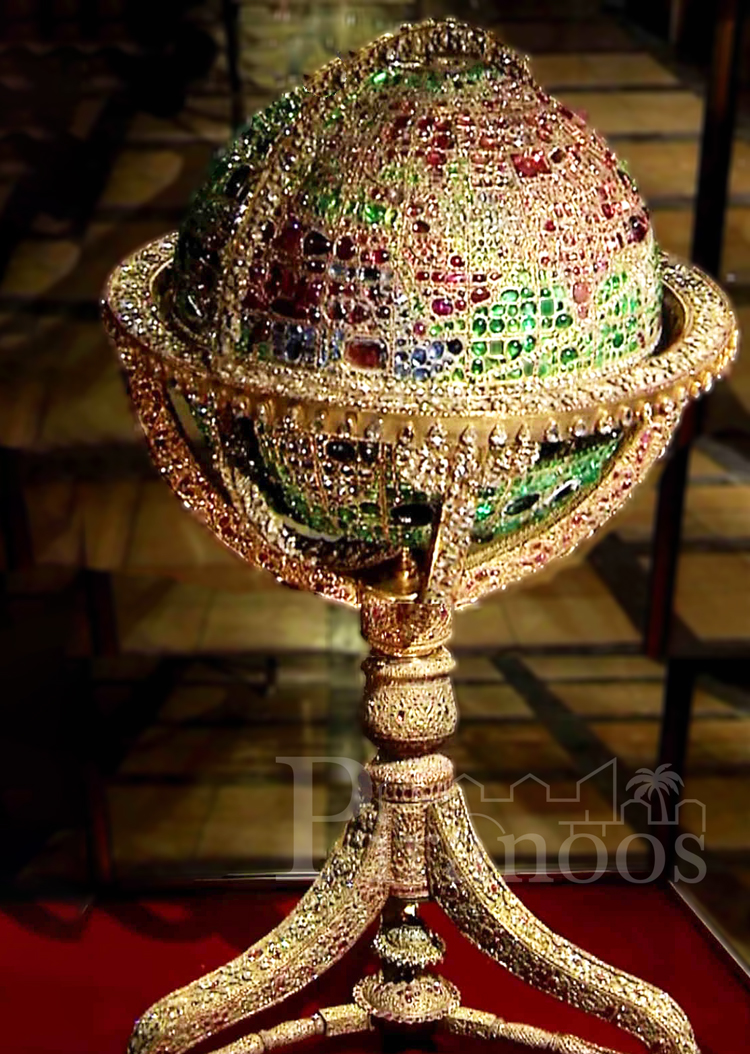 Koreh-e Javaherneshan (Jeweled Globe)
Koreh-e Javaherneshan (Jeweled Globe)Another most valuable treasure of the National Jewelry Museum is the Bejeweled-Globe that fascinates visitors at the end of the treasury hall, a huge globe decorated with an amazing amount of jewelry differing from anything anyone has ever seen. With the efforts of a group of Iranian jewelers overseen by Ibrahim Christian and ordered by Nasser al-Din Shah of Qajar, the Globe was built in 1856 using the jewelry available in the royal treasury. On the Globe, the seas are decorated with emeralds and the lands by rubies. Iran, England, and Southeast Asia are distinguishably ornamented with white diamonds, India with light color rubies, Central and South Africa with sapphire while equator and other geographical lines shine among these places. Interestingly, a rare sapphire called Aurangzeb (Mogul emperor of Hindustan 1658–1707) designates the city of Tehran, and a large sapphire represents Mount Damavand. The makers have highlighted all the geographical lines on the glob with diamonds. However, there is not much detail in defining the borders. Mounted on a base of gold and ornamented with jewelry, this dazzling glob is approximately 66 cm in diameter with 34 kg of gold and 3,656 grams of jewelry. This jaw-dropping “Golden Globe” beautifully enchants the visitors with its 51,366 pieces of jewelry.
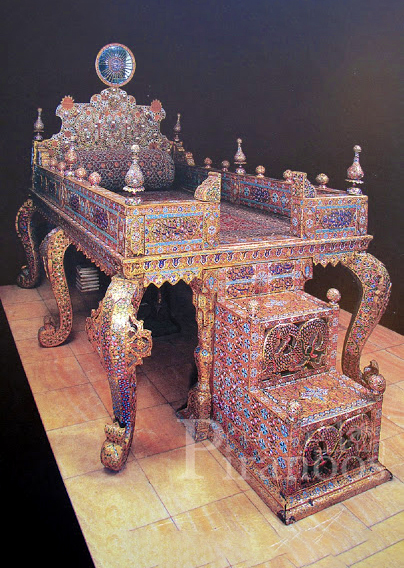 Among treasures of the National Jewelry Treasury is the famous and luxurious Peacock Throne, also known as the Sun Throne. In 1801, Fath Ali Shah of Qajar ordered the making of this unique imperial throne using the jewelry available in the royal treasury to Nezam al-Dawlah Mohammad Hussein Khan Sadr Isfahani, the Isfahan governorate. Initially, it was known as the Sun Throne because of a sun-figure on its headboard, but years later was named after Fath Ali Shah’s newlywed wife, Tavoos (Peacock).
Among treasures of the National Jewelry Treasury is the famous and luxurious Peacock Throne, also known as the Sun Throne. In 1801, Fath Ali Shah of Qajar ordered the making of this unique imperial throne using the jewelry available in the royal treasury to Nezam al-Dawlah Mohammad Hussein Khan Sadr Isfahani, the Isfahan governorate. Initially, it was known as the Sun Throne because of a sun-figure on its headboard, but years later was named after Fath Ali Shah’s newlywed wife, Tavoos (Peacock).
The Throne is 3.5 by 2.5 meters and made of red gold, pearls, and emeralds. Of interesting features of the Peacock Throne are the poems engraved on gold in Nastaliq script with azure glaze on the inscriptions around it.
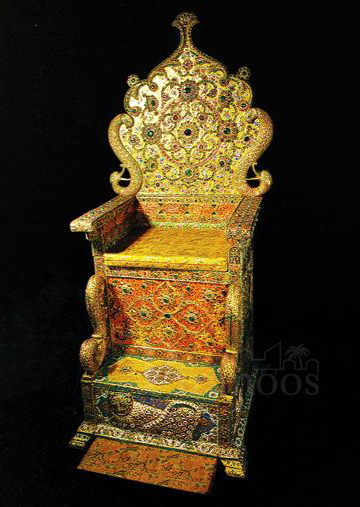 The Naderi Throne (Takht-e Naderi)
The Naderi Throne (Takht-e Naderi)The shape, composition, and decorations of the Naderi throne are more beautiful and impressive than the other famous Qajar throne. The backdrop of the throne has an Iranian ancient design Toranj, ornamented with large and small jewelry that intensifies its beauty. On both sides of the backdrop are two twisted dragons with eagle-shape heads. Also, there is the same figure with legs on the first step. Emphasizing the glory and beauty of the Throne is the embossed lion on the first step, and the two glazed parrot figures on arabesque netted Toranj patterns.
Of the magnificent items of the Treasure of Persia that unconsciously attract any visitor are the glittering Monarch Crowns and Tiaras on exhibit at Iranian National Jewelry Museum, among which is the Kiani Crown made in 1798 for Fath Ali Shah, the Qajar king. The crown adorned with precious gems like diamonds, emeralds, rubies, and pearls, resembles the design of a Sassanid crown. Aigrette and knurls decorated with various stones enhance the beauty of the crown. The crown’s height reaches 32 cm and is 19.5 cm wide. Since Reza Shah of Pahlavi was reluctant to wear the crown used by the Qajar at the coronation ceremonies, he ordered the Kiani Crown to be permanently transferred to the Jewelry Treasury.
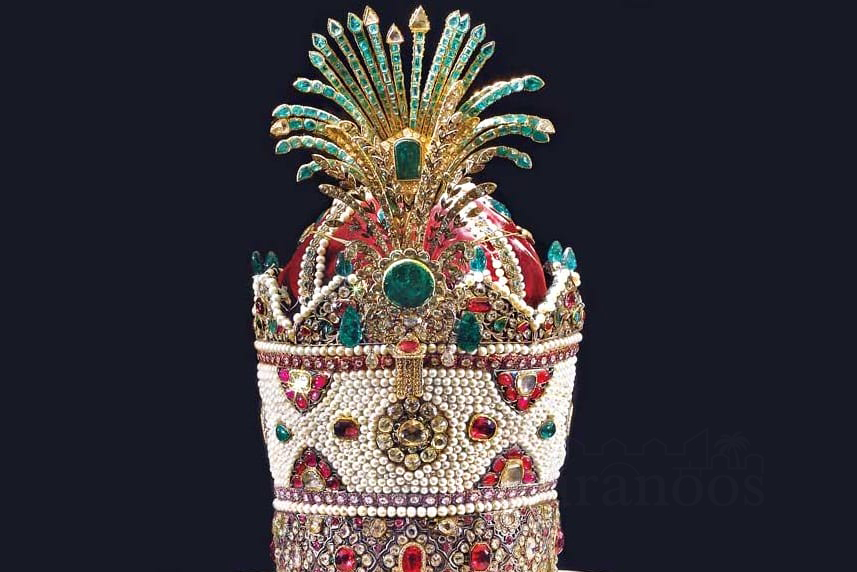
The most famous crown in the National Jewelry Treasury is the Pahlavi Crown. Made in 1926 for Reza Shah founder of the Pahlavi era, and to replace the Kiani Crown which had been used by the Qajar dynasty, the Pahlavi Crown, a masterpiece of elite Iranian jewelers under the supervision of Serajuddin Javaheri, a Caucasian original, and Amir Bukhara, a Russian migrate using some of the thousands of loose gems already in the Iranian Imperial Treasury was created. With a height of 29.8 cm and a width of 19.8 cm, this magnificent crown weighs nearly 2,080 grams. The Pahlavi Crown has a platform of gold and silver adorned with exquisite diamonds, large emeralds, sapphires, and pearls. The crown cap is red velvet with a large emerald on its cupola. The staircase-shape round the crown simulates the Sassanid style crowns (224 to 651 AD). A 60-carat astonishing yellow brilliant is centrally placed in the front resembling the sun with rays of white diamonds. A staggering 3,380 diamonds, totaling 1,144 carats, adorn the crown.
Coronations of Reza Shah on 25 April 1926 and his son and successor Mohammad Reza Shah Pahlavi on 26 October 1967, were the only two occasions the Pahlavi Crown was used.
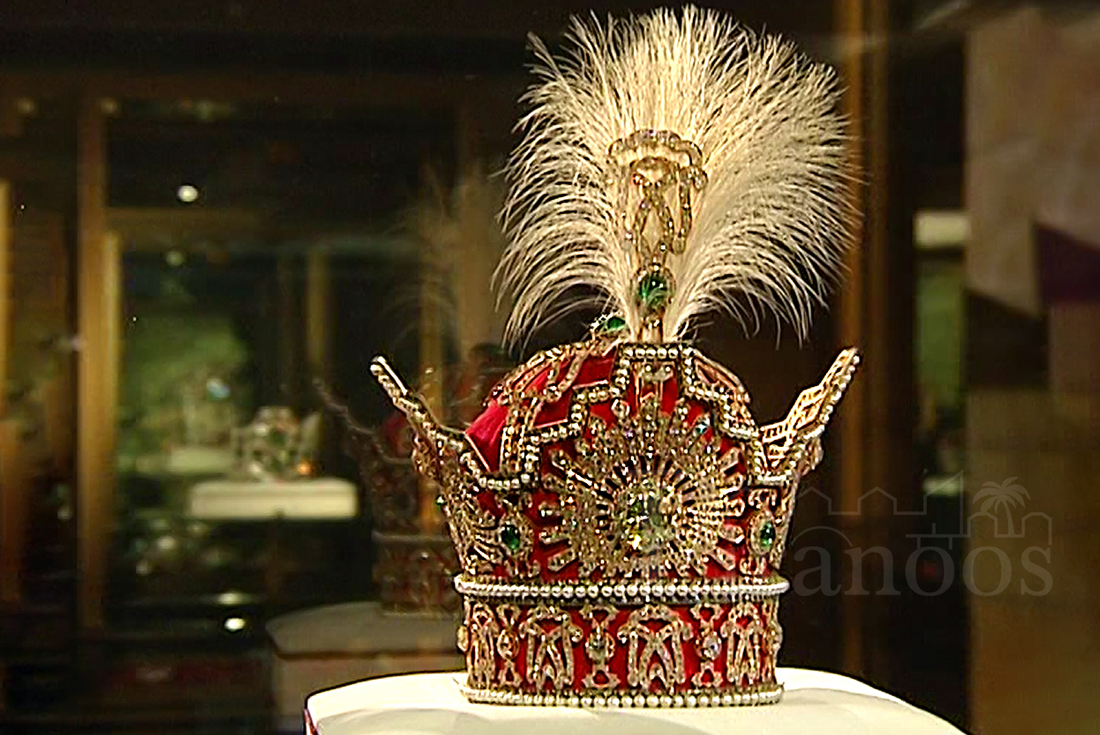
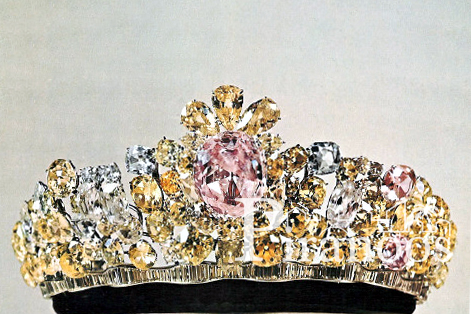
Of the most magnificent pieces in the National Jewelry Treasury is Nimtaj-e Nur al-Ayn, made for Farah Pahlavi, Mohammad Reza Shah’s third wife. This royal tiara is an iconic and delicate work of renowned New York jeweler Harry Winston. Worn by Farah on her wedding in 1959, the tiara was well-known for its rare pink diamond, the Nur-al Ayn (Nur-al Ayn is an Arabic female name meaning the eyesight referring to being preciousness). In research on the Darya-e Noor and the Nur-al Ayn diamonds, scientists concluded that they were originally one piece and were later divided into two. The large piece is the Darya-e Noor diamond, and the smaller piece weighing 60 carats is the Nur- al-Ayn.
Among the other famous royal crowns of the Treasure of Persia is the crown of Queen Farah Pahlavi. One of the reform plans of Mohammad Reza Shah was to grant freedom to Iranian women. Accordingly, in a symbolic move, the shah decided to hold a ceremony to crown the queen Farah, an effort that had never been done before in Iran. A French jewelry company, Van Cleef & Arpels, using precious stones jewelry from the royal treasury, made a most attractive crown worthy of the Queen. The crown adorned with 36 green emeralds, 105 pearls, 34 red rubies, 2 spinels, and 1,469 diamonds has a white gold frame over a green velvet cap. A 92-carat green emerald on the front center gives it a dazzling glow. Queen Farah described the crown as beautiful, yet very heavy, weighing two kilograms.The company also made a beautiful necklace for the queen coronation with a base of gold and platinum and adorned with a big emerald encompassed with diamonds, small emeralds, and pearls of one shape.
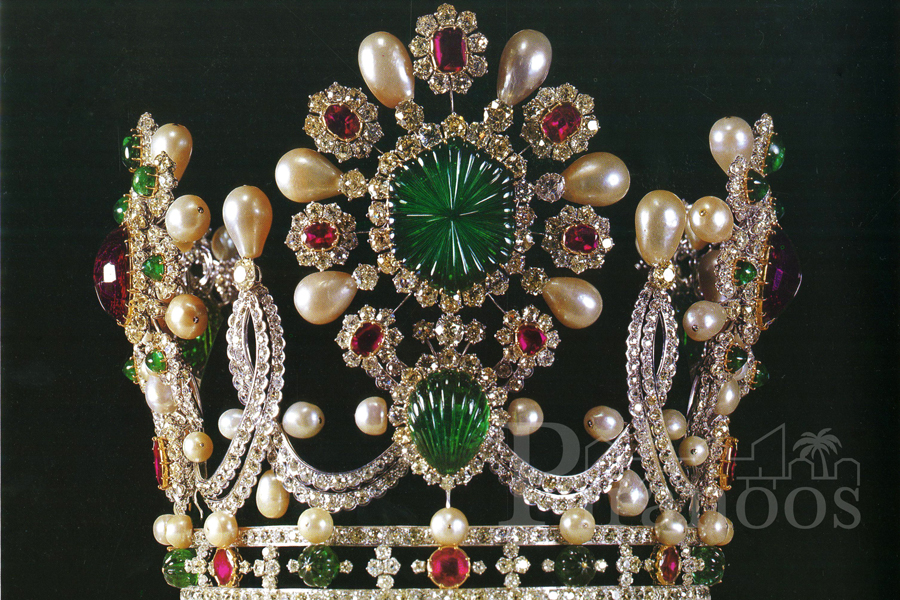
The belt is a 119 cm long gold strap with a unique and shining elliptical emerald weighing 176 carats. The emerald adorned with 60 pieces of Brilliant diamonds, and 145 pieces of Flamenco diamonds, gives a stunning shine to the belt. Nasser al-Din Shah of Qajar wore the Golden belt in various assemblies for boasting.
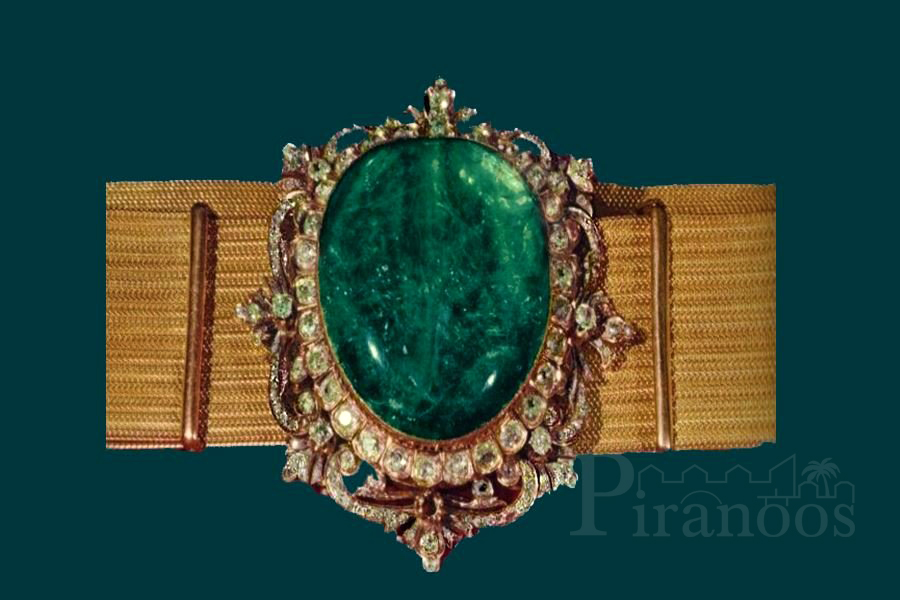
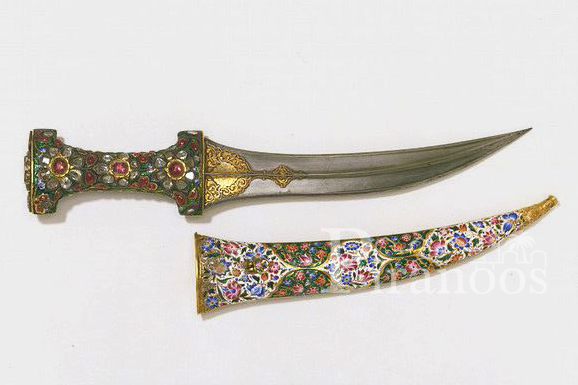 Royal swords and daggers adorned with emerald, sapphire, diamond, and motifs used in drills and various ceremonies by kings, courtiers, and princes e.g. the swords of Fath Ali Shah, Sultan, Nader Shah, and the Jeweled Dagger which are also on display at the National Treasury.
Royal swords and daggers adorned with emerald, sapphire, diamond, and motifs used in drills and various ceremonies by kings, courtiers, and princes e.g. the swords of Fath Ali Shah, Sultan, Nader Shah, and the Jeweled Dagger which are also on display at the National Treasury.
All the jewelry and artifacts described are just a small part of the jaw-dropping attractions and beauties of the National Jewelry Treasury. There are several more examples of each of the art pieces mentioned so far, some of them are masterpieces of Iranian and foreign artists, and some are offerings of other countries and governments to Iranian Emperors and Kings.
The National Jewelry Museum-treasury is located in the Treasury of the Central Bank of Iran on Ferdowsi Street in Tehran.
